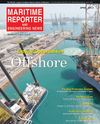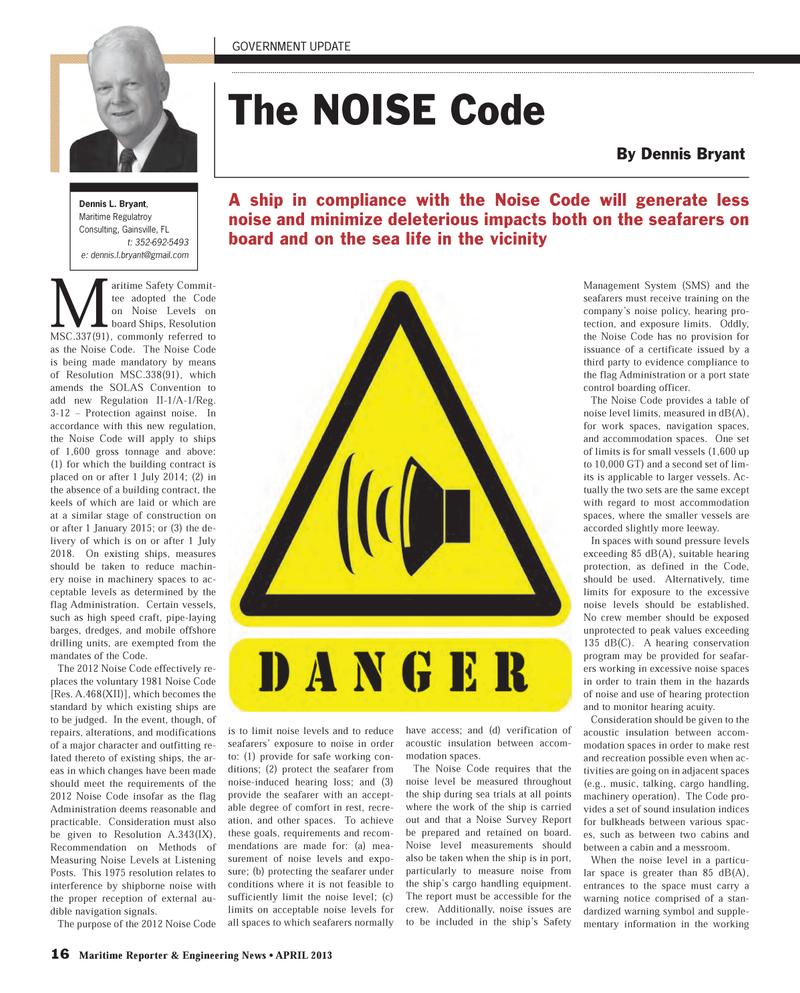
Page 16: of Maritime Reporter Magazine (April 2013)
Offshore Energy Edition
Read this page in Pdf, Flash or Html5 edition of April 2013 Maritime Reporter Magazine
16 Maritime Reporter & Engineering News ? APRIL 2013 GOVERNMENT UPDATE The NOISE CodeBy Dennis Bryant Dennis L. Bryant, Maritime Regulatroy Consulting, Gainsville, FLt: 352-692-5493e: [email protected] Safety Commit-tee adopted the Code on Noise Levels on board Ships, Resolution MSC.337(91), commonly referred to as the Noise Code. The Noise Code is being made mandatory by means of Resolution MSC.338(91), which amends the SOLAS Convention to add new Regulation II-1/A-1/Reg. 3-12 ? Protection against noise. In accordance with this new regulation, the Noise Code will apply to ships of 1,600 gross tonnage and above: (1) for which the building contract is placed on or after 1 July 2014; (2) in the absence of a building contract, the keels of which are laid or which are at a similar stage of construction on or after 1 January 2015; or (3) the de-livery of which is on or after 1 July 2018. On existing ships, measures should be taken to reduce machin-ery noise in machinery spaces to ac-ceptable levels as determined by the flag Administration. Certain vessels, such as high speed craft, pipe-laying barges, dredges, and mobile offshore drilling units, are exempted from the mandates of the Code.The 2012 Noise Code effectively re- places the voluntary 1981 Noise Code [Res. A.468(XII)], which becomes the standard by which existing ships are to be judged. In the event, though, of repairs, alterations, and modifications of a major character and outfitting re-lated thereto of existing ships, the ar- eas in which changes have been made should meet the requirements of the 2012 Noise Code insofar as the flag Administration deems reasonable and practicable. Consideration must also be given to Resolution A.343(IX), Recommendation on Methods of Measuring Noise Levels at Listening Posts. This 1975 resolution relates to interference by shipborne noise with the proper reception of external au-dible navigation signals.The purpose of the 2012 Noise Code is to limit noise levels and to reduce seafarers? exposure to noise in order to: (1) provide for safe working con-ditions; (2) protect the seafarer from noise-induced hearing loss; and (3) provide the seafarer with an accept-able degree of comfort in rest, recre-ation, and other spaces. To achieve these goals, requirements and recom-mendations are made for: (a) mea-surement of noise levels and expo-sure; (b) protecting the seafarer under conditions where it is not feasible to sufficiently limit the noise level; (c) limits on acceptable noise levels for all spaces to which seafarers normally have access; and (d) verification of acoustic insulation between accom-modation spaces.The Noise Code requires that the noise level be measured throughout the ship during sea trials at all points where the work of the ship is carried out and that a Noise Survey Report be prepared and retained on board. Noise level measurements should also be taken when the ship is in port, particularly to measure noise from the ship?s cargo handling equipment. The report must be accessible for the crew. Additionally, noise issues are to be included in the ship?s Safety Management System (SMS) and the seafarers must receive training on the company?s noise policy, hearing pro- tection, and exposure limits. Oddly, the Noise Code has no provision for issuance of a certificate issued by a third party to evidence compliance to the flag Administration or a port state control boarding officer. The Noise Code provides a table of noise level limits, measured in dB(A), for work spaces, navigation spaces, and accommodation spaces. One set of limits is for small vessels (1,600 up to 10,000 GT) and a second set of lim-its is applicable to larger vessels. Ac- tually the two sets are the same except with regard to most accommodation spaces, where the smaller vessels are accorded slightly more leeway. In spaces with sound pressure levels exceeding 85 dB(A), suitable hearing protection, as defined in the Code, should be used. Alternatively, time limits for exposure to the excessive noise levels should be established. No crew member should be exposed unprotected to peak values exceeding 135 dB(C). A hearing conservation program may be provided for seafar- ers working in excessive noise spaces in order to train them in the hazards of noise and use of hearing protection and to monitor hearing acuity. Consideration should be given to the acoustic insulation between accom-modation spaces in order to make rest and recreation possible even when ac-tivities are going on in adjacent spaces (e.g., music, talking, cargo handling, machinery operation). The Code pro- vides a set of sound insulation indices for bulkheads between various spac-es, such as between two cabins and between a cabin and a messroom.When the noise level in a particu-lar space is greater than 85 dB(A), entrances to the space must carry a warning notice comprised of a stan-dardized warning symbol and supple-mentary information in the working A ship in compliance with the Noise Code will generate less noise and minimize deleterious impacts both on the seafarers on board and on the sea life in the vicinity MR #4 (10-17).indd 16MR #4 (10-17).indd 164/1/2013 1:48:25 PM4/1/2013 1:48:25 PM

 15
15

 17
17
